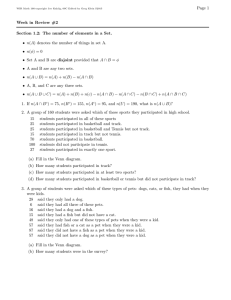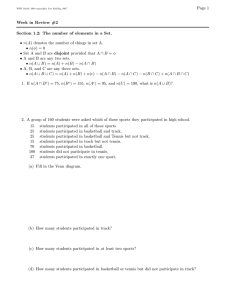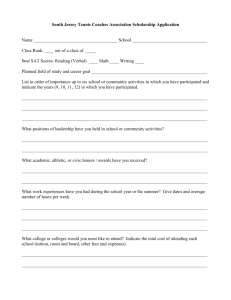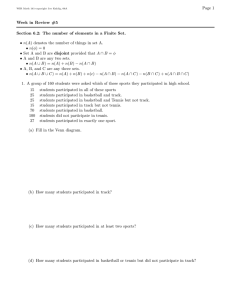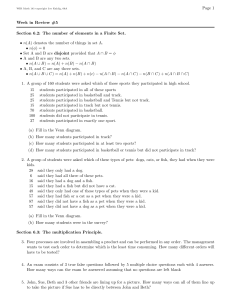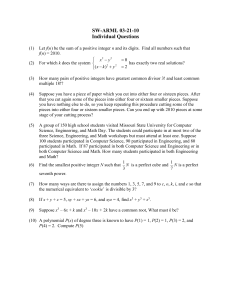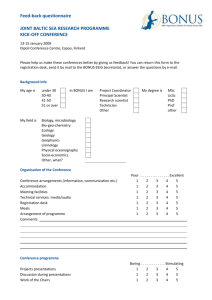Page 1 Week in Review #2
advertisement
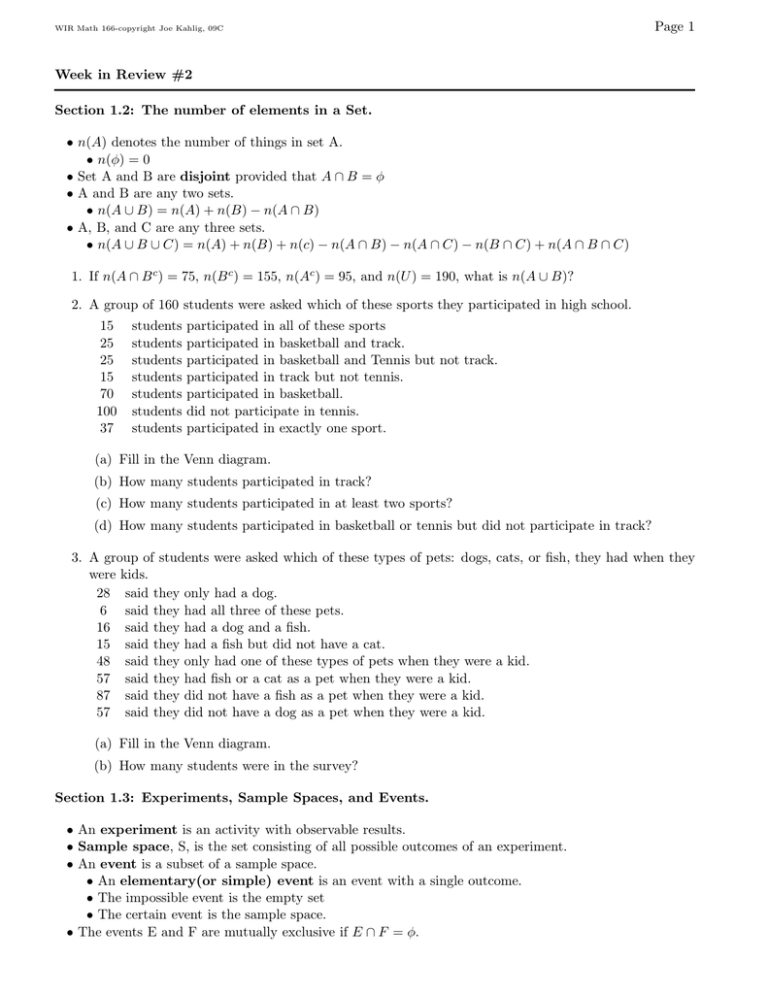
WIR Math 166-copyright Joe Kahlig, 09C Page 1 Week in Review #2 Section 1.2: The number of elements in a Set. • n(A) denotes the number of things in set A. • n(φ) = 0 • Set A and B are disjoint provided that A ∩ B = φ • A and B are any two sets. • n(A ∪ B) = n(A) + n(B) − n(A ∩ B) • A, B, and C are any three sets. • n(A ∪ B ∪ C) = n(A) + n(B) + n(c) − n(A ∩ B) − n(A ∩ C) − n(B ∩ C) + n(A ∩ B ∩ C) 1. If n(A ∩ B c ) = 75, n(B c ) = 155, n(Ac ) = 95, and n(U ) = 190, what is n(A ∪ B)? 2. A group of 160 students were asked which of these sports they participated in high school. 15 25 25 15 70 100 37 students students students students students students students participated in all of these sports participated in basketball and track. participated in basketball and Tennis but not track. participated in track but not tennis. participated in basketball. did not participate in tennis. participated in exactly one sport. (a) Fill in the Venn diagram. (b) How many students participated in track? (c) How many students participated in at least two sports? (d) How many students participated in basketball or tennis but did not participate in track? 3. A group of students were asked which of these types of pets: dogs, cats, or fish, they had when they were kids. 28 said they only had a dog. 6 said they had all three of these pets. 16 said they had a dog and a fish. 15 said they had a fish but did not have a cat. 48 said they only had one of these types of pets when they were a kid. 57 said they had fish or a cat as a pet when they were a kid. 87 said they did not have a fish as a pet when they were a kid. 57 said they did not have a dog as a pet when they were a kid. (a) Fill in the Venn diagram. (b) How many students were in the survey? Section 1.3: Experiments, Sample Spaces, and Events. • An experiment is an activity with observable results. • Sample space, S, is the set consisting of all possible outcomes of an experiment. • An event is a subset of a sample space. • An elementary(or simple) event is an event with a single outcome. • The impossible event is the empty set • The certain event is the sample space. • The events E and F are mutually exclusive if E ∩ F = φ. WIR Math 166-copyright Joe Kahlig, 09C Page 2 4. Suppose a card is randomly drawn from a standard deck of cards and the face value (denomination) is recorded. Find the sample space. 5. An experiment consists of selecting a letter at random from the letters in the word REPRESENTATIVE and observing the outcome. (a) Describe an appropriate sample space. (b) How many events does this sample space have? (c) Describe the event “the letter selected was a vowel”. 6. An experiment consists of picking an integer from 0 to 10. (a) Describe an appropriate sample space. (b) Describe the event E that the number picked was even. (c) Describe the event F that the number was a multiple of 3. (d) Describe the event G that the number was a multiple of 5. (e) Describe the event H that the number was odd and greater than 5. (f) Find the event F C ∩ (H ∪ G). (g) Which pairs of event, E, F, G, and H are mutually exclusive? (h) If the number 6 was picked, which of the events E, F, G and H occurred? 7. The numbers 0, 1, 2, 3, 4 are on separate pieces of paper in a hat. Two pieces of paper are drawn at the same time and the product of the numbers is recorded. Find the sample space. 8. Three quarters, four dimes and a nickel are in a piggy bank. Two coins are drawn at the same time and the total dollar amount is recorded. (a) Find the sample space. (b) describe the event a quarter is drawn. (c) Describe the event the total is less than $0.33. Section 1.4: Basics of Probability • Probability is a nubmer assigned to each outcome in an expirement that indicates how likely that ourcome is to occur with respect to the other outcomes in the sample space. • empirical probability is probability based off of repeated trials of an experiment. • sometimes called relative frequency. • probability properties • 0 ≤ probability of any outcome(simple event) ≤ 1. • the sum of the probability of all of the outcomes is 1 • a probability distribution is a chart that shows the outcomes and the probability associated to each outcome. 1 • For a uniform (equally likely) sample space, each outcome will have the same probability, n(S) . • To find the probability of an event E, add the probabilities of all of the outcomes in the event. • Probability formulas • P (E ∪ F ) = P (E) + P (F ) − P (E ∩ F ) • if E and F are mutually exclusive then P (E ∩ F ) = 0 • P (E) + P (E C ) = 1 or P (E) = 1 − P (E C ) 9. An experiment consits of selecting a digit from the number 11112233444445556777777 and observing it. Give the probability distribution for this experiment. Page 3 WIR Math 166-copyright Joe Kahlig, 09C 10. An experiment is to roll two 4 sided die(one red and one green) and record the product of the roll. Give the probability distribution for this experiment. Is the sample space uniform? 11. A sample of 100 college students were asked their party affiliation and whether they favor state lottery money used for welfare. Democrat Republican Independent total Favor 23 14 18 83 Not Favor 6 25 3 34 Unsure 7 4 0 11 total 36 43 21 100 A person is selected at random from the sample. What is the probability the person (a) Does not favor the use of lottery money for welfare? (b) Is a Republican? (c) Is an Independent who is not sure? 12. One card is selected from a standard deck of cards. What is the probability that the card is (a) a heart and a face card? (b) a heart or a face card? (c) not a club? (d) not a 4? 13. A jar contains six red marbles numbered 1 to 6 and eleven purple marbles numbered 1 to 11. A marble is drawn at random from the jar. Find the probability that (a) the marble is purple. (b) the marble is even. (c) the marble is purple or even. 14. A fair coin is tossed three times and heads ro tails is observed after each flip. What is the probability that (a) exactly one head is tossed? (b) at least two heads are tossed?
